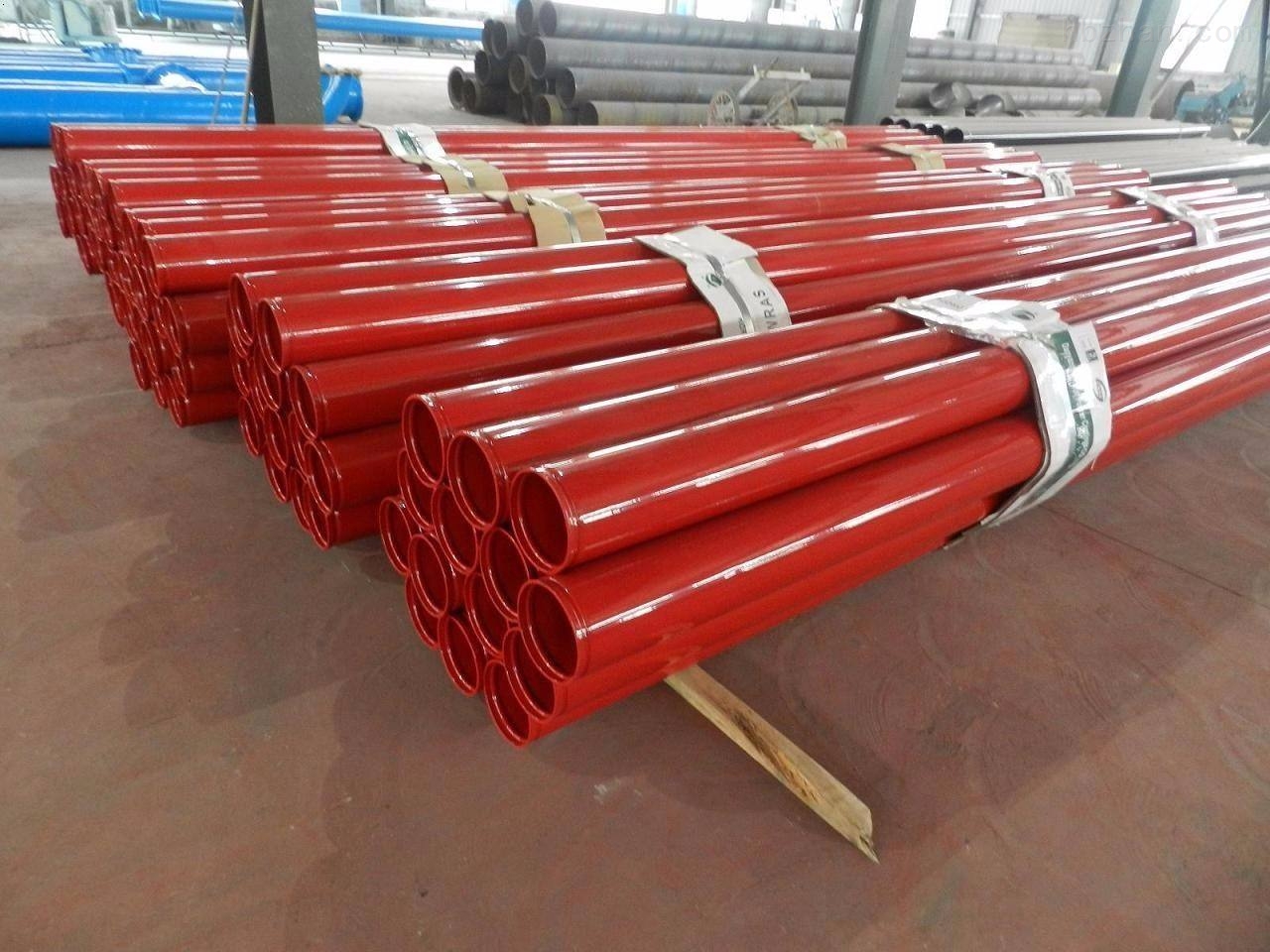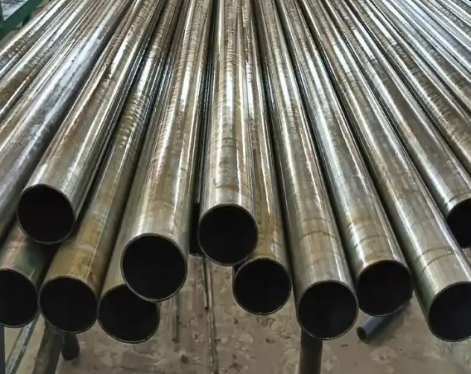Fire-fighting pipeline refers to the pipeline material used for fire-fighting, connecting fire-fighting equipment and equipment, and transporting fire-fighting water, gas or other media. Due to special needs, the thickness and material of fire-fighting pipes have special requirements, and red paint is sprayed to transport fire-fighting water. Since the fire-fighting pipeline is often in a static state, the requirements for the pipeline are relatively strict. The pipeline needs to be pressure-resistant, corrosion-resistant, and high-temperature resistant.
Requirements for Fire Piping
1. Fire sprinkler pipes should be selected according to design requirements, generally galvanized carbon steel pipes and fittings. It is required that the inside and outside of the pipe wall are evenly galvanized, no rust, no flying thorns, no biased parts, square buckles, incomplete threads, and inaccurate angles.
2. The pipe material of the fire hydrant system should be selected according to the design requirements. Generally, carbon steel pipe or seamless steel pipe is used. The pipe material must not have bending, corrosion, heavy skin and unevenness.
3. The thread sealing surface should be complete, without damage and without burrs.
4. The sealing surface of the flange should be complete and smooth, without burrs and radial grooves; the thread of the threaded flange should be complete and free of damage.
Process flow of pipeline installation
Installation preparation → dry pipe installation → alarm valve installation → standpipe installation → spray layered branch pipe, fire hydrant and branch pipe installation → water flow indicator, fire pump, high level water tank, water pump coupler installation → pipe pressure test → pipe flushing →Sprinkler branch pipe installation (system comprehensive pressure test and flushing) → throttling device installation → alarm valve accessories, fire hydrant accessories, sprinkler head installation → water adjustment test acceptance

Key points of fire pipe connection technology
1. Galvanized steel pipe screw connection
(1) Fire protection system pipes less than DN100 are made of galvanized steel pipes and connected with screws. When the pipeline is installed, the wire mouth should be smooth and complete without broken wires. The thread filler is made of tetrafluoroethylene raw material tape or white lacquered hemp silk. The pipe is tightened at one time, and the exposed part of the thread should be painted with anti-rust to protect it. The thread filler must not enter the pipe.
(2) The threaded connection of the pipeline is processed by an electric threading machine, and the processing times range from 1 to 3 times. The thread processing should be correct, clear, complete and smooth, without burrs and broken wires, and the total length of missing wires should not exceed 10% of the thread length.
(3) When threaded connection, the filler is made of white thick lacquered hemp silk or raw material tape, which is tightened once and cannot be screwed back, leaving threads after tightening.
(4) After the pipes are connected, clean up the stuffing squeezed out of the thread, and the stuffing should not squeeze into the lumen, so as not to block the pipeline, and at the same time, carry out anti-corrosion treatment on the exposed threads.
2. Groove (clamp) connection
(1) The maximum working pressure of grooved pipe joints with nominal diameter DN≤250mm is 2.5MPa, and the maximum working pressure of grooved pipe joints with nominal diameter DN≥300mm is 1.6MPa.
(2) Flexible joints should be used in places with vibration and buried pipelines, and steel joints should be used in other places. When steel joints are used, a flexible joint should be installed every 4 to 5 steel joints.
3. Screw connection
(1) In the system, the inner and outer wall hot-dip galvanized steel pipes or inner and outer wall hot-dip galvanized seamless steel pipes with pipe diameters < DN100 can be threaded. When the system uses hot-dip galvanized steel pipes with inner and outer walls, the pipe fittings can use forged cast iron threaded pipe fittings; when the system uses hot-dip galvanized seamless steel pipes with inner and outer walls, the pipe fittings can use forged steel threaded pipe fittings.
(2) If the wall thickness of the steel pipe is less than δ (3) When the pipe adopts 55° tapered pipe thread (Rc or R), the threaded interface can be sealed with PTFE tape. When the pipeline adopts 60° tapered pipe thread (NPT), it is advisable to use sealant as the seal of the threaded joint. Sealing tape shall be applied on male threads.
(4) Pipes with pipe diameter > DN50 shall not use threaded joints, and single reducing joints shall be used at the pipe diameter reduction.
4. Welding or flange joints
(1) The flange type can be divided into: flat welding flange, bimetal welding, butt welding flange and threaded flange according to the connection form. Bimetallic welded steel pipe is a new type of pipe, and the flange selection must comply with steel pipe flanges, steel butt-welded seamless pipe fittings, and PTFE-coated gaskets for pipe flanges.
(2) If the hot-dip galvanized steel pipe is connected by flange, threaded flange should be used. When the system pipeline adopts non-corrosion inner wall pipeline, it can be connected by welding.
Fire pipe installation requirements
(1) There should be no other water facilities on the pipeline after the alarm valve, and galvanized steel pipe or galvanized seamless steel pipe should be used.
(2) The pipeline for automatic sprinkler fire extinguishing shall be provided with a slope, and the slope shall be towards the drainage pipe or auxiliary drainage pipe. The slope of the dry pipe of the wet system shall not be less than 0.002°, and the slope of the water distribution pipe and branch pipe shall not be less than 0.005°.
(3) The diameter of all water distribution pipes or branch pipes shall not be less than 25mm.
(4) The nozzles installed on each branch pipe on each side shall meet the following requirements:
a. There should be no more than 8 buildings and structures of the light hazard level and the medium hazard level. When the same water distribution pipe is arranged with sprinklers above and below the ceiling, there should be no more than 8 nozzles on the upper and lower sides.
b. There should be no more than 6 seriously dangerous buildings and structures.
(5) The minimum distance between the pipe center and the building structure should comply with relevant regulations.
Requirements for Fire Piping
1. Fire sprinkler pipes should be selected according to design requirements, generally galvanized carbon steel pipes and fittings. It is required that the inside and outside of the pipe wall are evenly galvanized, no rust, no flying thorns, no biased parts, square buckles, incomplete threads, and inaccurate angles.
2. The pipe material of the fire hydrant system should be selected according to the design requirements. Generally, carbon steel pipe or seamless steel pipe is used. The pipe material must not have bending, corrosion, heavy skin and unevenness.
3. The thread sealing surface should be complete, without damage and without burrs.
4. The sealing surface of the flange should be complete and smooth, without burrs and radial grooves; the thread of the threaded flange should be complete and free of damage.
Process flow of pipeline installation
Installation preparation → dry pipe installation → alarm valve installation → standpipe installation → spray layered branch pipe, fire hydrant and branch pipe installation → water flow indicator, fire pump, high level water tank, water pump coupler installation → pipe pressure test → pipe flushing →Sprinkler branch pipe installation (system comprehensive pressure test and flushing) → throttling device installation → alarm valve accessories, fire hydrant accessories, sprinkler head installation → water adjustment test acceptance

Key points of fire pipe connection technology
1. Galvanized steel pipe screw connection
(1) Fire protection system pipes less than DN100 are made of galvanized steel pipes and connected with screws. When the pipeline is installed, the wire mouth should be smooth and complete without broken wires. The thread filler is made of tetrafluoroethylene raw material tape or white lacquered hemp silk. The pipe is tightened at one time, and the exposed part of the thread should be painted with anti-rust to protect it. The thread filler must not enter the pipe.
(2) The threaded connection of the pipeline is processed by an electric threading machine, and the processing times range from 1 to 3 times. The thread processing should be correct, clear, complete and smooth, without burrs and broken wires, and the total length of missing wires should not exceed 10% of the thread length.
(3) When threaded connection, the filler is made of white thick lacquered hemp silk or raw material tape, which is tightened once and cannot be screwed back, leaving threads after tightening.
(4) After the pipes are connected, clean up the stuffing squeezed out of the thread, and the stuffing should not squeeze into the lumen, so as not to block the pipeline, and at the same time, carry out anti-corrosion treatment on the exposed threads.
2. Groove (clamp) connection
(1) The maximum working pressure of grooved pipe joints with nominal diameter DN≤250mm is 2.5MPa, and the maximum working pressure of grooved pipe joints with nominal diameter DN≥300mm is 1.6MPa.
(2) Flexible joints should be used in places with vibration and buried pipelines, and steel joints should be used in other places. When steel joints are used, a flexible joint should be installed every 4 to 5 steel joints.
3. Screw connection
(1) In the system, the inner and outer wall hot-dip galvanized steel pipes or inner and outer wall hot-dip galvanized seamless steel pipes with pipe diameters < DN100 can be threaded. When the system uses hot-dip galvanized steel pipes with inner and outer walls, the pipe fittings can use forged cast iron threaded pipe fittings; when the system uses hot-dip galvanized seamless steel pipes with inner and outer walls, the pipe fittings can use forged steel threaded pipe fittings.
(2) If the wall thickness of the steel pipe is less than δ
(4) Pipes with pipe diameter > DN50 shall not use threaded joints, and single reducing joints shall be used at the pipe diameter reduction.
4. Welding or flange joints
(1) The flange type can be divided into: flat welding flange, bimetal welding, butt welding flange and threaded flange according to the connection form. Bimetallic welded steel pipe is a new type of pipe, and the flange selection must comply with steel pipe flanges, steel butt-welded seamless pipe fittings, and PTFE-coated gaskets for pipe flanges.
(2) If the hot-dip galvanized steel pipe is connected by flange, threaded flange should be used. When the system pipeline adopts non-corrosion inner wall pipeline, it can be connected by welding.
(1) There should be no other water facilities on the pipeline after the alarm valve, and galvanized steel pipe or galvanized seamless steel pipe should be used.
(2) The pipeline for automatic sprinkler fire extinguishing shall be provided with a slope, and the slope shall be towards the drainage pipe or auxiliary drainage pipe. The slope of the dry pipe of the wet system shall not be less than 0.002°, and the slope of the water distribution pipe and branch pipe shall not be less than 0.005°.
(3) The diameter of all water distribution pipes or branch pipes shall not be less than 25mm.
(4) The nozzles installed on each branch pipe on each side shall meet the following requirements:
a. There should be no more than 8 buildings and structures of the light hazard level and the medium hazard level. When the same water distribution pipe is arranged with sprinklers above and below the ceiling, there should be no more than 8 nozzles on the upper and lower sides.
b. There should be no more than 6 seriously dangerous buildings and structures.
(5) The minimum distance between the pipe center and the building structure should comply with relevant regulations.









